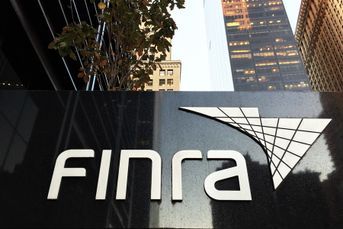New big kid on the block
 1
1
Goldman Sachs is pushing into services and markets it once thumbed its nose at. Should advisers be concerned?
Financial advisers’ newest competition isn’t a technology startup or consumer giant like Amazon or Google, as many have been fearing. Their latest challenge comes from one of the oldest names on Wall Street.
[More: Why we sold to Goldman Sachs]
As part of a plan to generate $5 billion a year in additional revenue by this time next year, international investment bank Goldman Sachs is doing what once would have been unthinkable: opening its doors to less-than-ultra-wealthy consumers. That means new digital banking products, consumer lending and financial advice for high-net-worth, mass affluent and even mass market investors.
“How embarrassing for 2006 Goldman is 2020 Goldman?” asked Lex Sokolin, global fintech co-head at ConsenSys. “It’s a 90-degree change of the brand — going from ‘We’re this elite, locked and closed platform for the wealthiest people in the world,’ shifting towards, ‘We’re creating access for everyone in the world to have high-quality Goldman investment products.’”
In May, Goldman Sachs spent $750 million to acquire United Capital, a registered investment adviser with 220 financial advisers and $25 billion in assets under management. While a drop in the bucket compared to the $427 billion managed by Goldman’s existing Private Wealth Management Group, the purchase establishes a foothold among HNW investors.
The acquisition includes FinLife Partners, the suite of white-label client engagement technology tools United Capital licenses out to independent RIAs. Goldman announced at Charles Schwab’s annual conference that it’s assigning Goldman veteran Rachel Schnoll to lead the team and grow that business. Now the investment bank owns an RIA and a fintech for outside advisers, two businesses it had little to no presence in just a year ago. And it isn’t stopping there.
[More: Goldman Sachs said to be near deal to buy United Capital]
Goldman is developing its own digital advice product, according to Reuters. Specifics are vague, but a robo-adviser would be a natural fit for Goldman’s digital bank, which it calls Marcus, providing personal loans and high-yield savings accounts with just $5,000 minimums.
Finally, Goldman is building a presence among mass market consumers as the bank behind Apple’s new credit card. It also owns Clarity Money, a personal finance app for mobile devices, and Honest Dollar, an automated IRA platform.
The next generation
“They want to be a player in every wealth segment, and they don’t want to lose the next generation,” said Scott Smith, director of advice relationships at Cerulli Associates.
An Apple credit card, a Marcus account or a robo-adviser could all be entry points into Goldman before the investor would graduate to United Capital, Mr. Smith said. If the individual reaches the C-suite of a large company, Goldman has additional services ready with Ayco, a retirement plan and wealth management platform for executives. Its private wealth management group will continue to offer white-glove service for its wealthiest clients.
Goldman will formally announce its multiyear strategy at its first-ever Investor Day on Jan. 29, but it isn’t difficult to put the pieces together. The firm once known for exclusivity is building connections with consumers across the entire financial spectrum, a potential pipeline of lifelong consumers to which it can sell increasingly more sophisticated financial products and services.
[More: Goldman Sachs sued for ‘unlawful’ 401(k) management
“These investments reflect our deliberate and disciplined approach in building new scalable businesses to serve a broader set of clients,” said David Solomon, Goldman’s CEO for the past year, on an Oct. 15 conference call discussing the firm’s quarterly earnings.
Helping people
The driving philosophy is to deploy Goldman’s financial expertise to help people regardless of where they are in their financial lives, said Tucker York, global head of wealth management, Goldman Sachs.
“There are different problems on one end of the spectrum from the other. Some people are focused on generational issues and others are focused on making the right kind of trade-offs, such as paying for college versus other expenses,” said Mr. York. He added that there is enormous business opportunity in expanding what Goldman has done for ultra-high-net-worth individuals and families to a broader spectrum of wealthy individuals.
“No matter the client issue, it’s all about working with individuals who have a genuine orientation around service and wanting to help make people’s lives better,” he said.
It remains to be seen if Goldman can pull off its vision; not everyone is convinced it can.
“I think it’s a lot harder to shift and expand the target market substantially like they are trying to do with wealth,” said Brennan Hawken, a senior equity research analyst at UBS who covers banks, brokers and asset managers.
Goldman has been successful in attracting the ultra-wealthy market with Private Wealth, but Mr. Hawken said that doesn’t necessarily translate to HNW or mass affluent consumers — markets with lots of competition.
“The fact that Goldman thinks it can walk in and have a huge impact? I’ll take the under on it,” he said.
The strategy shift comes after a tough decade for Goldman Sachs. New regulations, intense public scrutiny, low interest rates and changing technology after the financial crisis have contributed to stifling profits. Pretax earnings from Goldman’s trading division, once a powerful profit engine, fell 82% from 2009 to 2018. It’s down another 6% year-over-year in the first three quarters of this year.
[Recommended video: Perks and processes that top advice firms put in place to retain the best talent]
The bank has been slower to evolve than its competitors.
JPMorgan entered commercial and consumer banking in 2000 by merging with Chase Manhattan Bank. Today it offers wealth management to customers via Chase Private Client, and via digital platform You Invest.
Bank of America used its 2008 purchase of Merrill Lynch to launch Merrill Edge two years later. The firm’s electronic trading platforms for mass affluent investors now have assets of $223 billion.
Evergreen income
An even more direct comparison is Morgan Stanley, which had limited exposure to retail investors before it purchased Dean Witter Discover & Co. in 1997, said Danny Sarch, a recruiter with Leitner Sarch Consultants. Now wealth management generates a majority of the firm’s income.
“[CEO James] Gorman has turned it into a powerhouse. Look at how much money it’s generating, all evergreen income,” Mr. Sarch said.
In February, Morgan Stanley agreed to buy Solium Capital, an employee stock plan manager, for $900 million with hopes of converting some of the 2.5 million individuals on its platform, into advisory clients.
Goldman, in contrast, held its course for years, believing a steady hand on the wheel and commitment to its strategy would get it through the difficult time. But with shareholders losing patience, Goldman turned to Mr. Solomon, who ascended to CEO following Lloyd Blankfein’s retirement in 2018, to course correct. While he doesn’t fit the classic mold of a Goldman Sachs executive — he famously moonlights as an electronic dance music producer under the name DJ D-Sol — Mr. Solomon’s resume speaks for itself.
[More: Veteran Goldman Sachs executive to head United Capital FinLife tech]
Over his 10 years running Goldman’s investment bank, profit margins nearly doubled, and the division’s share of Goldman’s revenue rose from 11% to 22%, helping to offset slower trading.
Mr. Solomon is pushing the firm to diversify its business with revenue streams expected to be more stable and reliable than trading. Financial advice is clearly part of the plan, said Alois Pirker, research director for Aite Group’s wealth management practice.
“The revenue has lower peaks, but also less pronounced valleys,” Mr. Pirker said. “It’s an attractive thing for many firms, and Goldman hasn’t had that.”
With United Capital, Goldman has a small army of RIAs embedded in communities around the country serving HNW worth families and generating fee-based revenue. Even if those independent advisers don’t like being associated with the Goldman name, the fact that United Capital acquired the RIAs outright makes it difficult for them to leave, Mr. Sarch said.
“It’s seen as income that is more likely to stay without the same risk involved as the traditional broker-dealer model,” he said.
With FinLife Partners, Goldman gets not only a fintech business, but importantly, a vehicle to put its investment products in front of more independent RIAs. Like BlackRock’s investments in Envestnet and Aladdin, the strategy is likely less about selling technology and more about helping advisers with investment management.
[More: What does a Goldman-owned United Capital mean for advisers?]
“If you own the shelf, you have some say of what’s going on there,” Mr. Pirker said.
If Goldman’s moves down market with United Capital, Marcus and even Apple, Mr. Pirker sees Mr. Solomon using smart, long-term thinking about the market to identify areas that while underserved, are attractive and growing.
Between the recent elimination of commission fees and last week’s news that Charles Schwab Corp.was reportedly buying TD Ameritrade Holdings Corp., Goldman could look to acquire its own discount brokerage. Though Mr. Solomon denied plans to make another acquisition, buying a firm like E*Trade would align with Goldman’s new strategic direction and compete with Morgan Stanley’s Solium purchase, Mr. Hawken said.
Additionally, there are benefits to moving into new markets.
Without having to worry about replacing an existing business, Goldman can survey the landscape, develop or acquire what it determines is the best solution, and deploy in a strategic manner, said Cerulli Associates’ Mr. Smith.
Goldman’s advantage
Mr. Solomon clearly agrees, saying on a recent earnings call, “Our competitive advantage is that we have no legacy, branch or technology infrastructure, avoiding channel conflicts. … And yet we are a bank with a sizeable balance sheet and a well-recognized branch, which is needed for disruption.”
Goldman, however, will be challenged to reach new consumers. Firms like Vanguard and Charles Schwab jumpstarted entries into low-cost digital advice by moving over existing small accounts, while banks can cross-sell new investment products and services to its retail consumers.
While the marketing push for Marcus is already in full force, with ads running this fall during National Football League games, investment services could be more difficult.
[More: There’s a ‘turf war’ coming in financial advice]
It’s also not a given that the public is ready to trust one of the villains of the financial crisis.
“The vampire squid image, I think, has not been forgotten,” said Mr. Hawken, referencing a 2010 article in Rolling Stone about the investment bank. “Nobody assumes that Goldman’s reputation is meaningfully different.”
The partnership with Apple has already run into trouble, with Goldman facing criticism that its lending algorithms discriminate against women.
On the other hand, the PR damage Goldman faced after the financial crisis is no different than that of most other investment banks, or the entire financial services industry in general.
The bank didn’t alienate its core clients, and enough time may have passed for the consuming public, which has kind of a short memory when it comes to these things, Mr. Smith said.
Plus, Goldman can keep using the sub-brand names like Marcus and United Capital, or partner with giants like Apple, to change minds.
As for the client acquisition challenge, Goldman Sachs plans to lean heavily on its current relationships with corporate America to grow United Capital, Mr. York said. Companies offering Ayco’s retirement planning and wealth management to executive leadership want additional services for other employees, creating a unique pipeline of clients for United Capital.
“It makes them a very interesting firm to watch,” Mr. Pirker said. “What they end up with could look nothing like other firms out there.”
Learn more about reprints and licensing for this article.








